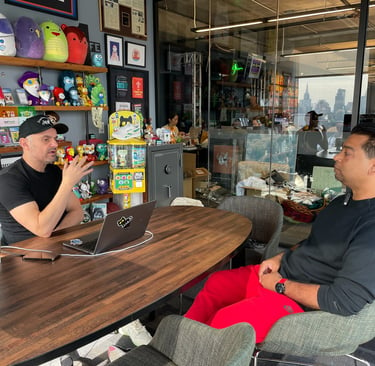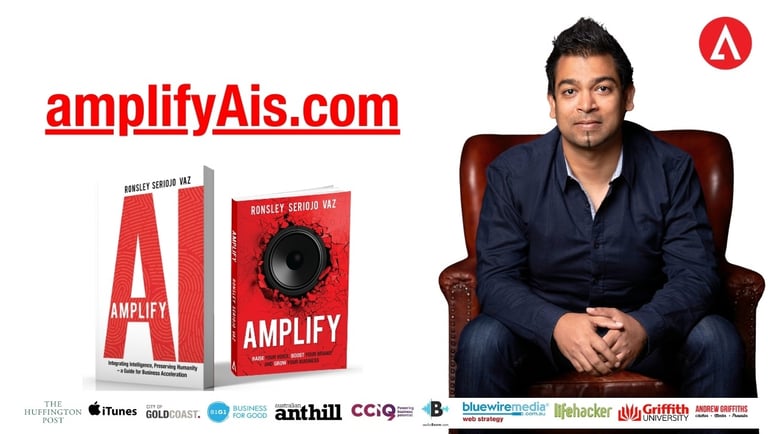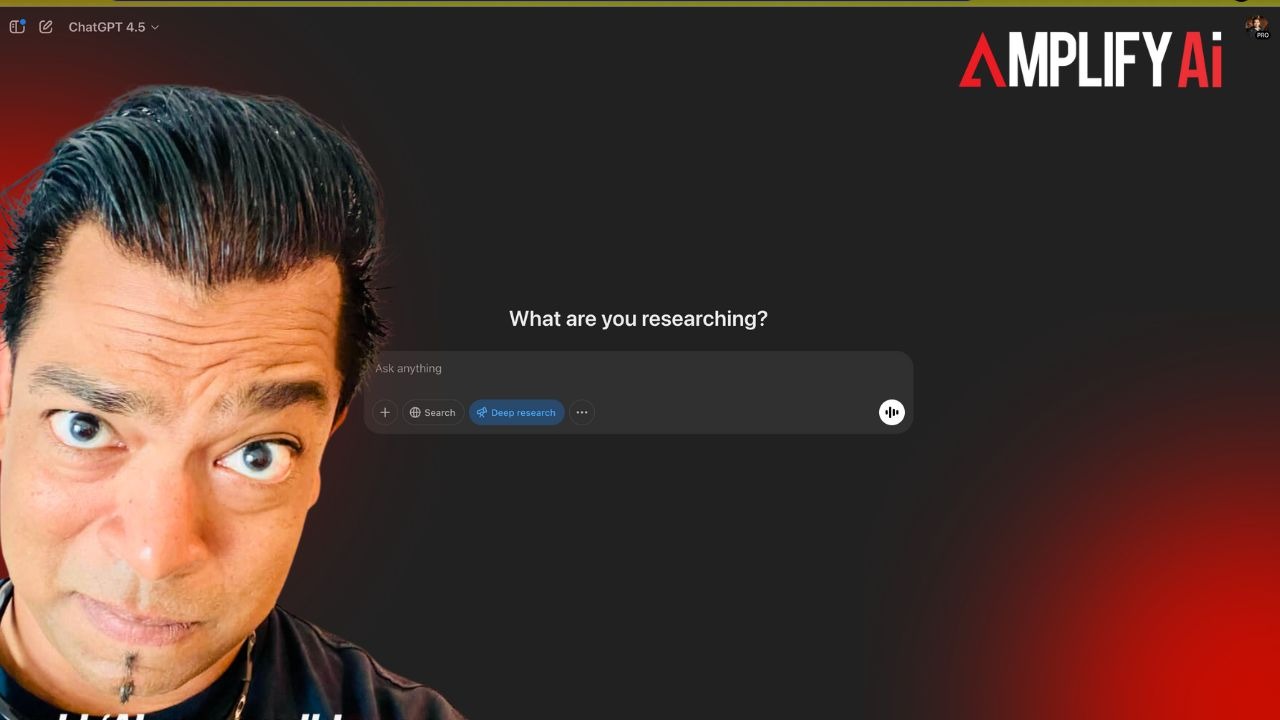What is Deep Research and how to use it as a business?
Most businesses waste time with shallow AI research. Deep Research is about asking questions that unlock genuine business growth. I'll show you the practical mechanics, tested strategies, and an implementation framework that gets results.
Ronsley Vaz
3/2/202521 min read


What is Deep Research and how to use it as a business?
ChatGPT’s Deep Research is an advanced capability that allows the AI to perform comprehensive, in-depth research on a topic by scouring multiple sources and consolidating findings. In practical terms, it acts like a research assistant that can read through dozens of articles, studies, and websites in minutes and distill the information for you.
This feature is immensely valuable for professionals – especially business founders, AI consultants, and content creators – because it delivers research-backed insights quickly. Instead of manually collecting data or scanning endless search results, you can leverage Deep Research to gather credible information for AI adoption strategies, content marketing plans, business growth tactics, productivity improvements, and creative ideation.
By using Deep Research effectively, you gain well-organised knowledge that can inform decision-making, support persuasive content, streamline your operations, and spark innovative ideas.
1/ How to Structure Effective Deep Research Prompts
Getting the most out of Deep Research requires giving ChatGPT the right instructions. The quality of the output greatly depends on the prompt. Here we’ll cover the key components of a good prompt, provide examples for each use case above, and explain how to refine prompts to improve results.
1.1 Key Components of a Good Prompt
When crafting prompts for deep research, keep these elements in mind:
Clear context and role:
Set the stage for ChatGPT by specifying who it should “act” as or what perspective to take. For example, “You are a market analysis expert” or “As an experienced HR consultant…”. This helps the AI tailor its language and the type of insights it will focus on.
Specific task or question:
Clearly state what you want to find out. A focused question yields more targeted answers. Instead of asking something broad like “Tell me about AI,” ask “What are the top 3 challenges mid-size hospitals face when adopting AI for patient care?”. The more specific you are, the more relevant and useful the answer will be. (One AI expert notes that the secret to great results is how you structure your query, starting with a clear, focused research question rather than a vague prompt .)
Relevant details and parameters:
Include any important context such as industry, timeframe, geographic region, or any parameters that matter. For instance, “in the US between 2020 and 2023” or “for e-commerce startups”. These act as filters so the AI searches within the right scope. If you have a particular focus (ethical concerns, cost factors, etc.), mention that too.
Desired depth and format:
If you need the information presented in a certain way, tell the AI. You might request a bulleted list, an outline, a table, or a step-by-step breakdown. For deep research, you can also encourage thoroughness by saying “provide detailed explanations” or “include data and sources.” Given that Deep Research can cite sources, you can ask for citations or for it to incorporate findings from specific types of sources (e.g. “using industry reports and reputable studies”).
Examples or sub-questions (if complex):
For multifaceted research topics, it helps to break the prompt into sub-questions or give an example. You might list a few specific questions you expect to be answered. This ensures the AI covers all aspects. If the topic is broad, explicitly listing the subtopics of interest will guide the AI’s research process.
By including these components, you set ChatGPT up to deliver a comprehensive and relevant answer. In short, be specific, be clear, and provide guidance. A vague prompt will produce generic output, whereas a well-crafted prompt will push ChatGPT to produce detailed, actionable insights.
Always remember: the prompt is basically your instructions to a very smart assistant – the better you instruct it, the better it can help you.
1.2 Refining Prompts for Better Results
Crafting the perfect prompt might take a few tries.
Don’t be afraid to refine and iterate.
One of the advantages of using ChatGPT interactively is that you can treat it like a conversation. If the first answer isn’t exactly what you need, analyse what might be missing or off-target, and then adjust your prompt or ask a follow-up. Here are some tips for refinement:
Provide more detail or narrow the scope:
If the output was too broad or generic, make your next prompt more specific. For example, if you initially asked “Give me trends in e-commerce,” you might refine it to “Give me 3 emerging trends in fashion e-commerce in 2024 among Gen-Z consumers.” Adding specifics (fashion, 2024, Gen-Z) guides the AI to a more focused subset of information.
Ask follow-up questions:
Often, Deep Research might give a comprehensive answer, but you realise you want to dive deeper into one part. You can directly prompt: “Can you elaborate on X?” or “Why is that the case?” or “Give me more examples of Y.” Because the model retains context, it will understand you are referring to the previous discussion.
If ChatGPT (especially in Deep Research mode) asks you a follow-up question for clarification, take that opportunity to clarify your needs – the AI is basically telling you it can give a better answer with more guidance. Embracing those follow-up questions can greatly increase the quality of the research outcome. In fact, refining the scope based on these interactions is often the difference between a merely informative answer and an actionable insight.
Break complex requests into parts:
If your prompt feels long or multifaceted, consider splitting into sequential queries. You might first ask for a summary of a topic, then ask for deeper analysis on one subtopic, then ask for specific examples. For instance, a founder could start with “Overview of AI in retail,” then follow up with “Now, what about AI use in inventory management specifically?,” and then “Any case studies on that?” This stepwise approach can yield a thorough exploration.
Experiment with wording and format:
Sometimes rephrasing the question can lead to better results. If “What are the benefits of X” gave a shallow answer, try “Explain the top 3 benefits of X and why they matter, with examples.” Little additions like “and why they matter” or “with examples” can prompt the AI to provide deeper reasoning and evidence.
Use iteration to hone in:
Think of each interaction as a chance to get closer to what you need. You might not get the perfect report in one go, but you can iteratively improve it. For example, after an initial answer, you could say: “This is a good start. Now please find data to back up point #2 and #3” or “Can you organise that information into a table for clarity?” The AI will refine its output accordingly.
I want you to treat prompt-writing as an interactive process. Start with the best prompt you can, then refine based on the output you get. Deep Research is powerful, but guiding it with an iterative mindset will take your results from good to great. Every follow-up or tweak is essentially you tuning the AI to better understand what you’re after – which leads to more effective research outcomes.
1.3 Common Mistakes to Avoid
While using ChatGPT’s Deep Research, users sometimes run into less-than-ideal results due to these common mistakes. Be mindful of them and try to avoid them in your research process:
Vague or overly broad prompts:
As emphasised earlier, a prompt that’s too generic will yield superficial answers. Asking “Tell me about my market.” is unlikely to produce useful insights. Such a broad query doesn’t tell the AI what aspect of the market you care about – trends, customer behaviour, regulations, competition, or something else?
Instead, narrow it down (e.g., “What are the current consumer buying trends in my market (home fitness equipment) and how have they changed since 2020?”). A specific question will guide the AI to fetch specific answers.
Tip: If you notice the answer seems generic, that’s a sign your question might have been too broad. Refine and try again with more detail.
Missing key context or parameters:
A prompt without context is like asking a question in a vacuum. For example, asking “How to implement AI?” is missing context – implement AI where or for what? In customer service? In manufacturing? Always provide the relevant background that frames your question. If you’re a podcaster researching a topic, mention the angle or audience you have in mind. If you’re a consultant looking at a business problem, mention the industry or scale of the business.
Including context such as the industry, target audience, time frame, or specific subtopic will help ChatGPT deliver an answer that’s tailored to your situation rather than a one-size-fits-all explanation. Missing parameters can lead to answers that feel off-target or needlessly generic.
Over-reliance on a single research source:
Deep Research will often cite multiple sources, but there might be cases where one source or one perspective dominates the answer (especially if one article had a lot of info). It’s dangerous to make a decision or publish content based on just one source. Avoid the trap of thinking the first answer is the full truth. Just as any good researcher would, use multiple sources and compare.
You can prompt ChatGPT to consider alternative viewpoints (“What do other experts say about this?”) or simply run a second query on the same topic to see if it brings in new information. The idea is to ensure you’re not unknowingly running with a biased or incomplete picture. Think of ChatGPT as a starting point – you should verify that the conclusions hold up across different reputable sources.
Not validating information before implementation:
This is crucial. ChatGPT might present information confidently, but that doesn’t guarantee accuracy. The AI can sometimes produce plausible-sounding but incorrect information – a phenomenon known as AI “hallucination”. If you skip verifying the details, you risk using incorrect data in your strategy or content.
To avoid this, always cross-check important facts, statistics, or recommendations with reliable external sources. Deep Research mode makes this easier by providing citations; click those citation links to read the original source and confirm the info. If a citation looks unfamiliar or the source isn’t clear, double-check via a quick web search. Especially before you implement a strategy change or publish content, ensure the facts and figures are validated.
Think of it as due diligence – the AI did the heavy lifting to gather info, but you are the decision-maker who needs to confirm it’s trustworthy. By combining ChatGPT’s findings with your own critical eye, you’ll avoid missteps and ensure accuracy.
By steering clear of these common mistakes, you’ll greatly enhance the quality of your research outcomes.
In essence: be specific, give context, use multiple sources, and verify everything critical. This way, Deep Research remains a powerful tool and not a potential pitfall.


2/ Use Cases
Deep Research can be applied to many scenarios. Each of these prompt templates below can be adjusted to your needs. The key is they all give enough context and direction to get a useful, detailed answer. You can literally copy these structures and replace the placeholders (___) with your specifics. Always remember to be explicit in what you ask for – if you want sources, say so; if you want a certain format, mention it.
Deep Research works best when you clearly outline the research mission for the AI.
Here are key use cases relevant to business founders, AI consultants, and podcasters, and how it adds value in each:
2.1 AI Adoption Strategies
For companies looking to implement AI, Deep Research helps uncover best practices, ethical considerations, and industry-specific AI applications. For example, an AI consultant or founder can ask ChatGPT to survey how AI is being adopted in their sector – it will compile case studies, success factors, and common challenges from various sources. This ensures your AI adoption plan is informed by what has (and hasn’t) worked for others.
Crucially, Deep Research can highlight ethical guidelines and risks (like bias, privacy issues) from expert reports, so you can incorporate responsible AI practices from the start. One CEO noted that successful AI adoption requires “careful consideration of potential benefits, costs, feasibility, strategic impact, and ethical considerations” – ChatGPT can quickly gather information on all these fronts to help you craft a holistic AI strategy.
By examining multiple industry reports and expert opinions, you get a balanced view on how to integrate AI in a way that aligns with your business goals and values.
Example Prompt: “You are an AI strategy consultant for the [industry] sector. Research and summarise 3–5 best practices for adopting AI in this industry, including any ethical considerations and relevant case-study examples. Focus on practical insights (e.g., how to integrate AI into existing processes, training staff, ensuring data privacy). Provide a brief explanation for each best practice, and cite sources or real-world examples to support them.”
(Why it’s effective:) This prompt gives a clear role (AI strategy consultant), specifies the industry of interest, and outlines exactly what information is needed (best practices, ethics, examples). It also asks for sources, which Deep Research can provide.
2.2 Content Marketing
In content marketing, research is king. Deep Research enables marketers and creators (like podcasters or bloggers) to generate research-backed articles, identify trending topics, and pinpoint audience pain points. You can have ChatGPT investigate what topics are currently hot in your niche by summarising blog trends or social media discussions. It can also dig into forums, reviews, or surveys to find what your target audience struggles with or cares about most.
For instance, one digital marketer uses ChatGPT to research their target audience and learn about their needs and pain points, then crafts marketing messages that resonate. With Deep Research, you could ask for recent statistics or case studies to add credibility to a blog post, or find anecdotal stories to make your podcast more engaging. The result is content that isn’t just creative, but also informed by data and real user insights – which can significantly boost your content’s effectiveness and trustworthiness.
Whether you’re brainstorming blog ideas or scripting a podcast, the AI can supply facts, examples, and fresh angles that keep your audience hooked.
Example Prompt: “Act as a content marketing analyst. I want to create content for [target audience or niche]. Using Deep Research, identify 2-3 trending topics or themes in this niche right now and explain why they are popular. Also, research the main pain points or challenges this target audience is discussing online (e.g., on forums, social media). For each trend or pain point, provide a short insight into how content could address it, supported by any data or quotes from sources.”
(Why it’s effective:) Here we set the AI as a content marketing analyst, and clearly ask for two things: trending topics and audience pain points, with context of a specific niche. The prompt specifies using online discussions as sources and asks for explanations and even data/quotes, which encourages the AI to pull concrete evidence, not just general statements.
2.3 Business Scaling
When scaling a business, knowledge of the market is power. ChatGPT’s Deep Research can function as a market research and competitor analysis tool, helping founders and consultants identify growth opportunities. You can task it with analysing your competitive landscape – for example, “Who are the top competitors in my industry and what are their strategies?” – and it will fetch details like competitors’ product offerings, target audiences, pricing strategies, and marketing tactics.
By analysing competitors’ strengths and weaknesses, the AI might highlight gaps in the market or unmet customer needs that your business can fill. Deep Research can also summarize industry trends (from news or reports) to inform your strategic planning. Want to know emerging consumer behaviours or new technologies in your sector? The AI can aggregate those signals for you. All this information feeds into strategic decisions about where to focus your efforts, how to differentiate your brand, and where to allocate resources for maximum growth.
Essentially, Deep Research provides a data-informed foundation for scaling up – be it entering a new market, improving your product, or sharpening your competitive edge – so you’re scaling with insight, not guesswork.
(Competitor Analysis) – Example Prompt: “You are a market research analyst. Conduct a competitive analysis for my company in the [industry/market] space. Focus on the top 3 competitors: for each, outline their key offerings/products, their target customer, and their unique strengths or advantages. Also note any weaknesses or gaps they have, and identify one opportunity for our company to differentiate or capitalise in response. Present the findings in a comparative format (bullet points or a brief table) and include any relevant market share info or statistics to contextualise their position.”
(Why it’s effective:) This prompt clearly specifies the task (competitive analysis) and the structure (cover top 3 competitors, specific points for each). By asking for strengths, weaknesses, and an opportunity, it ensures the output is actionable for business strategy. It even hints to include stats (market share) for depth. The role “market research analyst” primes ChatGPT to give a formal, fact-focused answer.
2.4 Productivity & Organisation
Founders and consultants often juggle many tasks, so optimising productivity is key. Deep Research can assist in finding the best tools, techniques, and methodologies to streamline workflows and improve organisation.
For instance, you could ask ChatGPT to research “top project management tools for small teams” or “proven methodologies for improving personal productivity,” and it will deliver comparative information and tips. It might detail techniques like Agile project management, the Pomodoro Technique for focus, or methodologies such as GTD (Getting Things Done), along with how to apply them.
Additionally, ChatGPT can help generate practical outputs to organise your work. It can draft to-do lists, suggest how to break down a complex project into milestones, or even create an outline for a standard operating procedure. In fact, users have found ChatGPT useful for task management and planning – it can assist in creating goal lists, prioritising tasks, and outlining project action plans with deadlines.
By leveraging Deep Research in this domain, you save time on scoping out productivity advice from countless blogs and instead get a distilled set of recommendations and tools tailored to your needs. The result is a more organised approach to work and potentially significant efficiency gains in your day-to-day operations.
Example Prompt: “You are a productivity expert and consultant. I’m looking for ways to optimise workflows for a [type of team or context] (e.g., a remote software development team, a solo entrepreneur, etc.). Using Deep Research, find 3 tools or techniques that have been proven to improve productivity or organisation for this context. For each tool/technique, explain what it is, how it helps streamline work or save time, and mention evidence of its effectiveness (such as a statistic, study, or successful example). If applicable, also note any prerequisites or costs associated. Provide the answer as a list of recommendations, each with a source or two for further reading.”
(Why it’s effective:) This prompt asks for specific solutions (3 tools or techniques) for a specific context, which guides the AI’s research. It also requests evidence of effectiveness, pushing the AI to include data or references (ensuring the recommendations aren’t just generic). The format requested is a list of recommendations, which keeps the answer organised for easy reading.
2.5 Ideation
Whether you’re a business owner developing a new product, an AI consultant devising a novel solution, or a podcaster planning fresh content, coming up with great ideas is crucial. ChatGPT’s Deep Research can supercharge ideation by acting as a creative brainstorming partner armed with knowledge. You can use it to explore inspiration for new products, services, or business models.
For example, you might prompt it to “brainstorm innovative uses of AI in education” or “suggest new podcast episode ideas on entrepreneurship trends,” and it will generate a range of possibilities. Because it draws from diverse sources and examples, the ideas it provides are often enriched by context. Deep Research excels at rapid idea generation – it can quickly produce a plethora of creative concepts when prompted with open-ended challenges. It can also integrate emerging trends into its suggestions.
Say there’s a rising technology or cultural trend; ChatGPT can incorporate those insights so your ideas are forward-thinking. Podcasters might discover angles for storytelling they hadn’t considered, and founders could uncover unconventional business ideas that break the mould. By using Deep Research in the ideation phase, you ensure your creative process isn’t limited to your personal experience or a quick Google search – instead, it’s augmented by a wide lens of information, sparking truly innovative thinking.
Example Prompt: “Imagine you are an innovation consultant and futurist. I run a business in the [industry] sector, and I want fresh ideas for new products or services. Generate 3 innovative business ideas that leverage emerging trends or technologies in this industry. For each idea, give it a name or tagline and describe the concept in a few sentences – explain what the product/service is, which customer problem it solves, and why it’s timely (e.g., related to a recent trend or change in the market). Additionally, mention any real-world inspiration or analogous examples if any (such as a startup or product that’s doing something similar for inspiration).”
(Why it’s effective:) In this prompt, the role is an innovation consultant, and it clearly asks for a specific number of ideas (3) with a structured description for each. By including “leveraging emerging trends or technologies,” we direct ChatGPT to incorporate current research or trend info into the ideas, making them grounded in reality. It also asks for reasoning (“why it’s timely”) which ensures the AI connects the idea to research about what’s happening now. This way, the brainstormed ideas are not just random – they are justified by current insights.

3/ Execution Strategy
Having a structured approach to using Deep Research will make your workflow efficient and effective. Here’s a step-by-step strategy for conducting deep research and applying the findings in a business context:
Define your objective.
Begin by clearly identifying what you need to learn or solve. Are you exploring how to adopt AI in your business? Looking for content ideas to boost your marketing? Investigating why a competitor is outpacing you? Define the scope of your research.
Writing down a one-line goal (e.g., “Understand the main challenges of implementing AI in retail inventory management”) can focus your efforts and make it easier to formulate a precise prompt.
Break the topic into key questions.
Once you have the objective, split it into a few sub-questions or components. Treat this like making a mini research plan. For example, if your goal is to develop an AI adoption strategy, sub-questions might be: “What are common pitfalls others faced?”, “What are the best practices recommended by experts?”, “What ethical issues should we watch out for?”.
This step ensures you cover all relevant angles. It’s a practice even AI power-users recommend – starting with a focused query and even listing specific questions you want answered. These sub-questions will directly inform the prompts you craft.
Craft an initial prompt (or series of prompts).
Using the principles from the previous section, write your first Deep Research prompt. Include the context, the specific task, and any parameters. If it’s a complex topic, you might decide to do this in a couple of separate prompts (one per sub-question) rather than one huge prompt – that’s fine. The goal here is to ask for exactly what you need.
For example: “You are a market analyst. Summarise the current market trends in [your industry] and identify 3 growth opportunities for new entrants. Provide data or examples for each trend.” Make sure to specify if you want sources cited. Double-check that your prompt isn’t missing any clarity; a quick mental test is to imagine you’re giving this prompt to a human researcher – would they know what to do? If yes, then it’s clear enough for the AI.
Run the Deep Research query (and be patient).
Enter your prompt and let ChatGPT’s Deep Research mode do its work. It may take a little longer than a standard query because it’s actually going out and gathering information. You might see it “thinking” or note that it’s searching through sources. Give it the time it needs to compile the answer – usually it’s just a minute or two at most. The result should be a detailed response, often with citations or reference numbers.
Review the output thoroughly.
Once ChatGPT provides the answer, read through it carefully. Don’t skim – make sure you understand the points it’s making. Note what findings or recommendations it gave. Pay special attention to any data points, claims, or surprising insights. Also look at the sources if provided (they might be listed as footnotes or in-line citations like【source】).
As you review, assess whether the answer fully addressed your question or if there are gaps. Sometimes the answer might be detailed but you realise you wanted an extra perspective – jot that down for a follow-up.
Investigate the citations and verify facts.
A huge advantage of Deep Research is that it provides sources for its information. Use this! Click on the cited sources or copy the reference to find the original. Skim those source articles or papers to verify the context and accuracy of what was cited. This step is your fact-checking safety net.
For example, if the AI says “According to a 2024 survey, 60% of consumers prefer X over Y,” click the citation and confirm the survey actually says that. Verifying a couple of key facts will boost your confidence in the material. Moreover, reading the sources can give you even more detail or nuance (since the AI’s summary might condense things).
Cross-checking multiple sources ensures you’re getting a reliable picture. If you find any discrepancies or something that looks off, you can address that with a follow-up question to ChatGPT or by consulting another source.
Refine or ask follow-up questions (if needed).
Based on your review, decide if you need more information. This is the iteration step. You might prompt ChatGPT again to fill in any gaps. For instance, “This is great, but can you also find info on how much budget companies typically allocate for AI projects in retail?” or “Can you break down the trend #2 you mentioned by age group?” Essentially, dig deeper where you need clarity.
If an answer was too generic, refine your prompt and run it again. This could be a quick tweak or a new prompt. Each round, you’re honing in on the precise insights you need. Remember, ChatGPT can handle follow-ups in the same conversation context, so you often don’t need to restate everything – a question like “What about in Europe specifically?” can work if it’s a direct continuation. Use this interactive capability to your advantage until you feel you have a comprehensive understanding of the topic.
Extract key insights and organise them.
Once you have all the information you need (from one or multiple prompts), distill the findings. It helps to write down or highlight the most important points that emerged. For example, list the top 3 insights that answered your main question, or the pros/cons you learned, etc. You can even ask ChatGPT to provide a summary of its findings to ensure you didn’t miss anything (“Summarize the key takeaways from the above research in 3 bullet points”).
Organising the information might involve copying the relevant text and sources into a document or note-taking app. At this stage, look for patterns or connections among the data – this is something you as a human do best. Maybe several sources all pointed to a similar challenge, or perhaps an idea came up that sparks a solution for you. Take note of these overarching themes or any surprising insights. (Deep Research can surface a lot of data; your job is to turn that into knowledge by identifying what matters for your context.)
Apply the research to your strategy or decision.
Now comes the whole point of the exercise – using the insights. Integrate what you’ve learned into your business strategy, content, or project. If you were researching for a strategy document, start writing that document, backed by the findings (with citations as needed). If it’s for a content piece, incorporate the data and angles into your outline or script.
For a decision like a business move, weigh the research insights as part of your decision criteria. It often helps to discuss these findings with your team or stakeholders: “According to the research via ChatGPT, these are the trends and here’s how we might respond…”. By presenting the information (and even citing the sources you got), you also add credibility to your proposals. Essentially, you’re translating research into action.
Ensure that any plan or content piece directly addresses the insights – for example, if the research highlighted a big customer pain point, make sure your strategy has a solution for it, or your content speaks to it. This is how you turn raw information into real-world impact.
Iterate periodically and stay updated.
Deep Research isn’t a one-and-done deal. Especially in fast-moving fields (like AI or digital marketing), the landscape changes. Make it a practice to revisit important research questions regularly. You might schedule a monthly or quarterly deep research session on relevant topics to keep strategies up-to-date.
The iterative approach also means that after implementing something, you come back and research again to evaluate or explore the next step. For example, if you used Deep Research to plan an AI adoption strategy and you’ve started executing it, you might later use it to find metrics for success or case studies on companies six months post-adoption.
Keeping an iterative, learning mindset ensures you continuously refine your business with the latest insights. Integrating new research into decision-making becomes a cycle of improvement.
By following these steps, you create a structured workflow for deep research: from defining the question, gathering information, verifying it, to applying it. This not only makes the process efficient but also maximises the quality of outcomes. You’re effectively collaborating with the AI – letting it handle the heavy lifting of information gathering and initial analysis, while you guide the process, verify the facts, and apply human judgment to make decisions.
This synergy of AI speed and human insight is powerful. In fact, leveraging such a structured approach can help maintain a competitive advantage in research-intensive tasks, as you’re able to glean data-driven insights faster than others.


4/ Things to think about
ChatGPT’s Deep Research feature can be a game-changer for business founders, AI consultants, and content creators when used correctly. It offers the ability to rapidly gather and synthesise knowledge from across the web, giving you a rich foundation for strategies, content, and ideas. To maximise its value, keep the following final recommendations in mind:
Be intentional and structured:
Know what you’re looking for, and approach the research in a methodical way (as outlined in the steps above). A little planning goes a long way in ensuring the AI digs up what you actually need.
Craft clear, targeted prompts:
This cannot be overstated – the quality of your prompt drives the quality of the result. Use the templates and examples as starting points, and continuously hone your prompting skills. A well-structured prompt is often rewarded with an in-depth, well-structured answer.
Leverage the AI’s strengths, but apply your own expertise:
Deep Research is fantastic for quickly retrieving information and even spotting patterns, but human judgment is irreplaceable. Always interpret the findings in the context of your unique situation and knowledge of your industry or audience. The AI might tell you what is happening; you still decide what to do about it. Combine the AI’s breadth of information with your depth of understanding. (In other words, the AI is an adviser, but you are the decision-maker.)
Verify and trust-but-verify:
Enjoy the speed and convenience of having information at your fingertips, but never skip the verification step for critical details. Trust the process of Deep Research to surface relevant info, but verify important facts before you run with them. This balanced skepticism will save you from potential pitfalls of misinformation. It also helps you gain confidence in the AI’s outputs over time, as you see which things check out.
Stay ethical and considerate:
When formulating AI adoption strategies or content strategies with the help of AI, remember to include ethical considerations and diverse perspectives. Deep Research can uncover ethical guidelines, opposing viewpoints, and potential biases – use that to make more responsible decisions. (For example, if research shows a certain AI application might negatively impact privacy, factor that into your plan.) Encouraging the AI to present multiple angles can lead to more well-rounded conclusions.
Iterate and learn:
Think of each deep research session as part of an ongoing learning journey. The more you use it, the better you’ll get at asking the right questions. If something didn’t work well, treat it as a lesson – refine your approach next time. Encourage a culture (within your team or personal workflow) of backing up claims with research and continuously seeking out knowledge. Over time, this will make your strategies and content not only stronger but also more adaptive to change.
ChatGPT’s Deep Research is a powerful ally for those willing to use it thoughtfully. It can reshape your workflow by cutting down research time and uncovering insights that might be missed otherwise, all while underscoring the importance of keeping human oversight in the loop.
By approaching it in a structured and iterative way, you ensure that you’re not just getting information, but actionable intelligence that drives smarter strategies, better content, and innovative ideas. Embrace an attitude of curiosity and verification, and you’ll find Deep Research to be an indispensable part of your toolkit for business growth and creativity.
Happy researching!
See you at work.
Much love,
Ronsley






